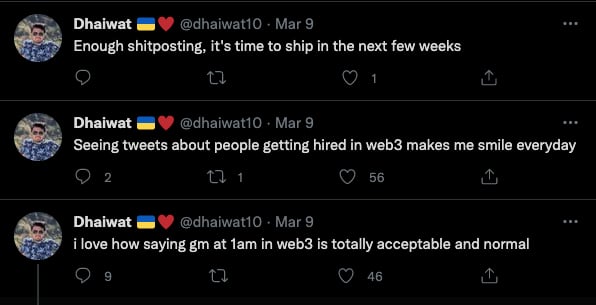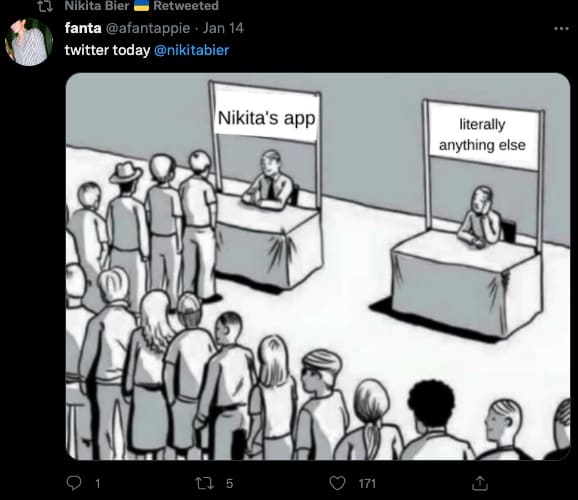



In early 2020, Nicaia D’Souza - then 25 years old and unemployed - became very active on Twitter. Dissatisfied with the jobs that came her way because of her vocational education and experience in the hospitality sector, she decided to take a break to pursue her interest in the music festival scene in India. But as the pandemic intensified, physical events took a backseat and D’Souza found herself spending hours on social media. She looked at the microblogging site as a place to have meaningful discussions and share her opinions on a wide range of topics.
“I started finding ways to offer my opinion in a manner that was kind as well as adding value to the discussion,” said D’Souza, who was inspired by writer and coach David Perrel’s description of Twitter as a library of ideas and a social club.
When she saw a tweet from Raj Kunkolienkar asking people for their best Spotify recommendations, D’Souza replied with a dozen playlists that she had curated to match a certain vibe. That’s how Kunkolienkar, founder of Stoa, an online business school, and D’Souza, a music junkie and self-proclaimed Twitter shitposter, got talking.
D’Souza invited Kunkolienkar to a WhatsApp group she managed for music recommendations. Impressed with her enthusiasm, empathy and knack for bringing people with similar interests together, Kunkolienkar offered her a job as a community manager for Stoa.
A year into this fulltime role now, D’Souza continues to use Twitter as a sounding board to shitpost and often builds friendships along the way.
Shitposting is the posting of controversial or off-topic “hot takes” on social media, mainly to create a stir or distract from the main conversation. A term born on the internet, Urban Dictionary describes a shitpost as a post of little to no sincere insightful substance. Especially a “shit” (low)-effort/quality-post with the sole purpose to confuse, provoke, entertain or otherwise evoke an unproductive reaction.
A meme can be a shitpost, but a shitpost by itself doesn't have to stick to a repetitive format like a meme. A shitpost is funny because it isn’t a predictable repetition of an existing form.
Since its inception, shitposting has gotten a bit of a reputation – from being used frivolously by people bored on the internet to being used as a trolling tool in presidential elections. In the past couple years, though, Gen Z and millennials in India have found a way to use it as a way to raise their hands and sometimes even get a chance to be seen and heard.
Neha Reddy, 22, who describes herself as “unhinged, uninhibited and dehydrated” in her Twitter bio, is a serial shitposter. Reddy, who got active on Twitter last year, said she discovered an internship marketing role at Antler, an early-stage venture capital firm, through the platform and applied for it. A fulltime marketing analyst at the investment firm now, Reddy says young people voicing their opinions on social media has also led to them getting a seat at the table.
“Social media platforms like Twitter give a peek into your work and personality that transcends a conventional resume. We can now showcase our work, build in public and access spaces like VC firms that have conventionally been gatekept,” said Reddy. “Getting a foot in the door is getting easier.”
Antler has committed one-third of its capital this year to back founders in the Web3 space – a term used loosely for the new iteration of internet based on decentralised blockchain technology– probably recognises that the early adopters and builders in this area are Gen Z and millennials. An early stage fund, Antler, on its India website, calls for student founders and first time entrepreneurs to pitch them.

Shitposting as an entry point in the workforce discourse in India is relatively new. According to Google trends, shitposting became an internet trend in India around 2015, spiking around December 2016, shortly after the US presidential elections, when news around the meme-fication of the elections was doing the rounds. The next highest spike for shitposting in India was in April 2021, when the second lockdown started during the Covid-19 Delta wave. Millennials and Gen Z took to social media as a form of expression to find their tribe.
Young Indians are now using shitposting innovatively, to say the least. Building a social media profile that goes beyond the traditional resume and isn’t fixated on pedigree or background, Gen Z and millennials are shitposting as a differentiator to stand out in a crowd. The openness of social platforms like Twitter allows people from all backgrounds to use social media cleverly as a means to discovery.
Sunil Panwar, 21, from Jhalamand village in Jodhpur, comes from a lower income household. Panwar, who worked as a child to support his family and couldn’t afford a college education, discovered the power of social media to build communities.
At a recent Web3 meetup in Bangalore, Panwar stood out from the usual techie crowd as a representative of rural India eager to build solutions in the metaverse and got himself multiple backers. What he lacked in formal education, he made up with his social media chops and got himself a gig as a community builder at OGCLUB, a community for Web3 enthusiasts in India.
“Shitposting gets more reactions and engagement than gyaan-based threads on Twitter,” said Panwar, a self-taught social media expert. He’s now on a mission to bring the challenges of rural India to the fore and help others like him from small towns find opportunities in the tech corridors.
Beyond social media rolesThere’s an uptick of activity on Twitter, where those with similar technological and non-tech interests, including design, product management, software development, building in Web3 and even social movements like no-code and low code are bringing people together and engaging in discourses, often starting with shitposting.
Unlike other social media platforms, Twitter relies on text and is a perfect place to shitpost. The Twitter algorithm also ensures it serves content you’d be interested in even if it doesn’t come from people you follow. The platform that historically relied on users to manually follow accounts recently introduced features like Topics and Communities to give users tweets it thinks they will want to see.
Pragun Dua, 21, who shitposts about everything from his love for ghee podi dosa to accidentally twerking in front of a CEO at a party, says that opening up on various aspects of life in front of strangers brings people together.
In December, Dua, who was hunting for an internship as a design engineer, put out a Tweet showing off his design skills through an animated meme with a black screen that a second later lights up only his face, giving off a scary vibe. Dua captioned the image: “Hire me or I’ll haunt your dreams.”
Funnily enough, the tweet acted as an icebreaker. Several people engaged with the tweet and Dua scored an interview with Headout, an online experience marketplace for travellers, where he currently has the role of a UX designer.
“Shitposting is a great icebreaker,” said Dua. “If you post only about work, it becomes as boring as LinkedIn. If you are posting fancy pictures, there’s enough of that on Instagram. But platforms like Twitter and Discord are where your thoughts are on display. It allows you to connect with more people who share the same interests.”
Shitposting acts as a gateway for people to notice you. But it only gets you to the gate.
“Once someone lands on your profile or decides to look you up because they were intrigued, you need to have proof of work to show you can be a valuable asset,” said Dua.

Using shitposting as a gateway, Gen Z and millennials are building their brands on Twitter, pushing their products in Discord communities and focusing on proof of work to increase their visibility to land more varied and unconventional roles.
Surat-based Dhaiwat Pandya, a final year Bachelor of Computer Science student and a Web3 enthusiast, says the key to shitposting right is to keep it real, raw and to know that there is a limit. He says even though shitposting increases engagement, people can mostly see through a post that’s meant solely for engagement.
“After every two, three days I make it a point to post about technical stuff and learnings too,” said Pandya, who is building a library of reusable components in Web3 and posts short video demos of them.
Pandya was discovered on Twitter by his current employer Mazury, a metaverse platform, where he moonlights as a frontend developer. He is also involved in other Web3 projects like community platforms Moonshot collective and DeveloperDAO.
Pandya says the pandemic in some way blurred access boundaries for people in small towns and opened up opportunities for people like him who don’t live in the metros or have Ivy League degrees to land unconventional roles that did not exist earlier.

Every new generation has people who challenge the status quo and change the way the world works by a bit. Gen Z, known to be more sensitive to issues like mental health and environment, are also more open to taking gap years, forgoing traditional education in exchange for experience, opting for three part-time gigs in different time zones instead of one cushy job, and building products for the future world.
So how do young, opinionated people with no professional degree or work experience show the world their capabilities and find a platform to speak? Sure, social media presence helps, but in order to get discovered and find a community that listens to your thoughts and gives you a chance, you need to be more than talented. You need to be relatable and approachable.
Sejal Sud, 20, a business administration and law degree student at OP Jindal University who has garnered a community of 46.2K followers on Twitter, says that building a community is about bringing your multidimensional personality on a platform.
“The most likable leaders are the ones who are relatable,” said Sud, who regularly hosts Twitter spaces, the platform’s live audio conversation feature that allows anyone to join in as a listener.
It makes perfect business sense for someone like Kunkolienkar of Stoa school or founders of other bootcamp courses that have come up recently to build in public on Twitter. Indian startup founders that cater to Gen Z and the younger audience that is more willing to experiment and challenge traditional jobs and education systems also use shitposting as a medium to reach them.
“For startup founders, building and maintaining their own reputations online is no longer a luxury but rather a requirement today,” said Ritesh Banglani, a partner and founder at Stellaris Ventures, a VC firm. Banglani says founders are aware that prospective employees, customers and investors are all on social media, so that is where you need to engage them. But keeping it real is what makes you click with people.
“People are good at filtering out fake attempts at engagement and gravitate towards those who help you think, learn or laugh,” said Banglani, whose Twitter posts are a mix of startups, parenting, cricket and observational humour.
Founders of startups like Growth School and Invact Metaversity that offer bootcamp and cohort-based courses with emphasis on skill training over professional degrees often use Twitter to share unconventional opinions that generate engagement and call for criticism but eventually start a dialogue on challenging conventional educational approaches.


This also highlights a dangerous trend of young and impressionable people getting swayed into believing the whims of leaders they follow. It could lead young minds to develop a binary thinking approach without realising the nuances of life or the accountability of their actions. Deciding to take a gap year based on the response to your tweet is a dangerous slope for a young person.


Posts by high-impact shitposters like Tesla and SpaceX founder Elon Musk and former US president Donald Trump can have an outsized reaction in the real world, too. The value of cryptocurrency Dogecoin went up by 25 percent hours after Musk tweeted a meme about it.

Unlike the Amazons and Coca-Colas of the world that swore to take their “secret sauce” to their grave, startup founders have adopted the ‘building in public’ model over the past few years. Evolved as a marketing strategy that partly works on the psychological premise of trust that comes from transparency, founders have been sharing more threads, Medium posts and LinkedIn pulse articles than ever before.
Building in public, which is essentially storytelling in action, acts as a powerful tool that makes readers root for the storyteller. Entrepreneurs like Sahil Lavingia, founder of self-publishing digital marketplace Gumroad, and Ankur Warikoo, founder of Nearbuy who has been creating brand Warikoo through his content that targets Gen Z, flaunt their failure stories like a chip on their shoulders.
Young people who look up to these entrepreneurs not only connect with them as a part of their communities but also learn from their personality traits and talk about their failures on their Twitter timelines.


Opening up about various facets of their personalities also acts as a behavioural resume for companies looking to work with young people.
Kunkolienkar of Stoa, who describes himself as a shitposter in his Twitter bio, says that he’s discovered many interesting people on the platform and recruited them after reading their inputs on Twitter.
“If you observe a person closely on Twitter and you see them making sense or having a different but interesting view on a topic most of the time, you know that they are worth exploring,” said Kunkolienkar.
Banglani of Stellaris Ventures says following someone on the platform gives you a full perspective of their work personality. It is unthinkable to hire someone today without scanning their social media, he says.
Of course, it is not the right tool to assess technical competence, he admits. But social media gives you an insight into people’s social and behavioural skills.
“Are they thoughtful? Do they shoot from the hip? Do they engage with people respectfully or get into fights? Do they help others? These skills are naturally more important in some roles than others,” he added.
Deepti Chopra, founder of Adaface, a recruitment assistance startup, says that even though most recruiters and employees still follow traditional hiring methods, an interesting social media profile of a person can act as a secondary resume that is not as made up as the primary one. Chopra, who says she developed a “Twitter brain” after observing the platform for a few months, says that shitposting or funny anecdotes also help with the recall value of the brand you’re building.
“Sharing real stories make you more relatable as opposed to a black box only spouting startup gyaan,” Chopra said.
Shitposting to build communitiesAfter it got infamous for its role in the US elections in 2014, shitposting as a term also evolved. Creators and marketers started talking about shitposting as a medium to build communities. Peter Yang, product lead at Reddit and author of The Art of Writing, wrote about how he built a community of 50K followers on Twitter and 10K newsletter subscribers through a combination of useful advice and shitposting.
“The coming together of Web3 enthusiasts on social media for collaboration is a great example of how humour and shitposting can act as an important factor in the initial growth of a community,” said Dua.
D’Souza, the community manager at Stoa who got active on Twitter only a couple years ago, says that people who shitpost are either trying to be relatable or having a tough time and trying to joke about it.
Essentially, it is people trying to feel less alone. Shitposting acts as a great way to start the line of communication with someone who has similar interests without coming on strongly.
“Shitposters also turn into memes either of their own making or turn into the subject of a meme by others, but because they’re shitposters, it doesn’t burn as much I suppose,” said D’Souza.
Within the Twitter bubble or the subcommunity of startups, people hype each other up by creating a meme format that acts like an inside joke but also allows new people within the community to contribute to it.
Nikita Bier, creator of tbh, an app built around the concept of hyping your friends up anonymously, probably got the idea for it from the time he spent on Twitter.
“The big milestone of the last social apps was the ability for open discourse [like on] Twitter. That was a great achievement” Bier’s team said in this TechCrunch report. “We think the next milestone is thinking about social platforms in terms of love and positivity. We think that’s what’s been missing from social products since the inception of the internet.”
Bier’s Twitter timeline, filled with memes of how investors are beelining beyond city limits outside his house, or how the insomniac partner is unable to sleep because he’s thinking of Nikita’s new app (and not other women) or how people in tech are naming their first-born Nikita, is a testament to how the culture of hyping up brings people together.

 Back home, when Suhas Motwani, a product manager at PepsiCo, angel investor and a well-known name in the India’s product community, posted about moving back to India, he probably received a grander welcome on Twitter memes than in real life. Motwani responded to all these memes with a humble chuckle in replies.
Back home, when Suhas Motwani, a product manager at PepsiCo, angel investor and a well-known name in the India’s product community, posted about moving back to India, he probably received a grander welcome on Twitter memes than in real life. Motwani responded to all these memes with a humble chuckle in replies.

He acknowledges that the shitposting culture with him as the main character in the Twitter startup subculture helped with his reach in the ecosystem. His popularity also comes from being a community player in real life. He runs a cohort-based course for Web3 enthusiasts to connect and learn from each other.
Motwani says every startup founder wants to have a community but building one is a long game and expecting returns on the investment within a year can be counterproductive.
Communities are generally a bunch of people rooting for a common cause. And bonding over relatable humour can be a great entry point.
“A lot of people know me through my work, but many other people also know me because of the memes and shitposting on Twitter. Also, it acts as a great inbound funnel where I get to discover more interesting people,” said Motwani.
It’s still early days for this phenomenon, which is largely restricted to the startup bubble on Twitter. But it already has outliers challenging the social norms that open the windows of opportunity to only English-speaking, degree-holding, thread-writing and influential tech bros.
“Even if startup Twitter is a bubble, it still provides opportunities for skilled people from small towns with non-tech backgrounds and basic education if you learn how to network on the platform,” said Panwar from Jhalamand village, who was taken in by the Web3 community in Bengaluru.
Panwar, who goes by the Twitter handle of TheCeoSahab, says Gen Z is smart at figuring out how to use social media to network and it will eventually bring more diversity in the tech and startup space.

Discover the latest Business News, Sensex, and Nifty updates. Obtain Personal Finance insights, tax queries, and expert opinions on Moneycontrol or download the Moneycontrol App to stay updated!
Find the best of Al News in one place, specially curated for you every weekend.
Stay on top of the latest tech trends and biggest startup news.